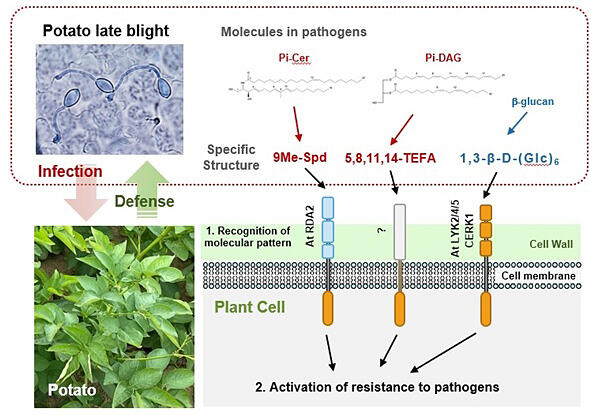A research group led by Professor Daigo Takemoto, Professor Emeritus Makoto Ojika and Professor Emeritus Kazuhito Kawakita of the Graduate School of Bioagricultural Sciences at Nagoya University, and Program-Specific Researcher Hiroaki Kato of the Graduate School of Agriculture at Kyoto University has announced that they successfully isolated two plant immunity-activating substances, "Pi-Cer D" and "Pi-DAG," from the cell membrane components of the potato late-blight pathogen Phytophthora infestans and determined the structures of these substances, which are recognized by plants as foreign substances and induce many resistance reactions. They also confirmed that pretreatment of plants with these substances prevents disease development. The findings are expected to contribute to the development of biostimulants (activators of immunity) and were published in the June 3 issue of the international journal Plant Physiology.

Provided by Nagoya University
The potato late-blight pathogen P. infestans was responsible for severe famine in Europe in the mid-19th century and still causes an estimated annual economic loss of 6.7 billion US dollars worldwide. Plant pathogens include bacteria, fungi, and oomycetes, and how plants recognize the components of these pathogens to activate immune responses has been studied from the perspective of disease control. Plants combat invading pathogens through these immune responses; however, oomycetes such as P. infestans had yet to be sufficiently studied.
In this study, the research group purified P. infestans resistance inducers recognized by plants, aiming to clarify the mechanism by which plants recognize oomycete attacks. Since the addition of a P. infestans culture fluid to potato cells induces the production of reactive oxygen species and antimicrobial substances, which are typical plant resistance reactions, this culture fluid was separated, extracted, and purified using various column chromatography methods. They succeeded in isolating a ceramide compound (Pi-Cer D), which is recognized by plants as a foreign substance that induces the production of reactive oxygen species, and diacylglycerols (Pi-DAGs), which induce the production of antimicrobial substances. Treatment of potato leaves with Pi-Cer D induced reactive oxygen species production in the leaves. Treatment of potato tubers with eicosapentaenoic acid (EPA), a substructure of Pi-DAGs, induces the production and accumulation of antimicrobial rishitin in the potato tubers. Both treatments were found to greatly reduce infection rates following the addition of P. infestans.
They further analyzed the structures recognized by plants in Pi-Cer D and Pi-DAGs and found that the structures are 9Me-Spd and 5,8,11,14-TEFA, respectively, both of which are not found in plants but are found specifically in fungi and oomycetes. These structures present in the membranes of pathogenic microbes were identified as microbe-associated molecular patterns (MAMPs), which plants use as signatures to recognize pathogens. They also confirmed that treatment with Pi-Cer D and Pi-DAG before exposure to the pathogen reduced infection in potato by at least 90% and increased resistance.
A comprehensive analysis and comparison of gene expression in plants treated with Pi-Cer D and EPA showed that each substance activated the expression of a different group of genes. Each of these substances was also recognized via different receptors in plants. When plants were treated with a mixture of the two compounds, many genes expressed were those that did not respond to treatment with each compound alone. The two substances discovered in this study induced resistance not only in potato, but also in rice (Oryza sativa) and Arabidopsis thaliana (family Brassicaceae), indicating that they are recognized by pathogen-sensing mechanisms that plants share.
Takemoto commented, "Currently, we are conducting research to clarify how plants recognize the pathogen structures discovered in this study. In conventional agriculture, crops are well fertilized, and pests are controlled as much as possible using fungicides and insecticides. This is a well-established technology underpinning our food supply, but it needs to be converted to sustainable agriculture because of its environmental impact. One promising material is biostimulants. Different biostimulants and their function discovery in the future are expected to be useful for sustainable agriculture."
Journal Information
Publication: Plant Physiology
Title: Two structurally different oomycete lipophilic microbe-associated molecular patterns induce distinctive plant immune responses
DOI: 10.1093/plphys/kiae255
This article has been translated by JST with permission from The Science News Ltd. (https://sci-news.co.jp/). Unauthorized reproduction of the article and photographs is prohibited.




